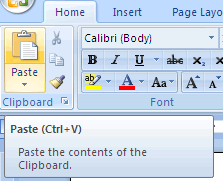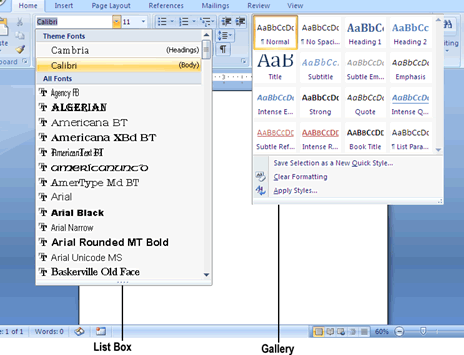Using the Ribbon
The Ribbon organizes commands into categories called contextual tabs. Each tab displays a different group of commands. For example, the Page Layout tab displays only those commands related to designing a page, and the Insert tab displays only those commands related to inserting items into a file, such as a page break or a picture. Each tab displays a different group of related commands.
Using the Ribbon is a two-step process. First, you must click the tab that contains the command you want. Second, you click the actual command.
Tabs act exactly like traditional pull-down menus. Whereas a pull-down menu simply displays a list of commands, tabs display a list of icons that represent different commands.
Deciphering Ribbon icons
The main idea behind organizing commands within tabs is to avoid overwhelming you with a barrage of different commands. Although most icons include a short text description, you can get additional help deciphering different icons through ScreenTips, which typically displays the following:

- The official name of the command (which is Paste shown in figure)
- The equivalent keystroke shortcut you can use to run the command (which is Ctrl+C in the figure)
- A short explanation of what the command does
To view the ScreenTip for a command, move the mouse pointer over a command and wait a few seconds for the ScreenTip appear.
Shortcut keystrokes let you choose a command from the keyboard without the hassle of clicking a tab and then clicking the command buried inside that tab. Most shortcut keystrokes consist of two or three keys, such as Ctrl+V or Ctrl+Shift+C.
Using Live Preview
In the past, you might have known what a particular command did, but you would never know how it would affect your file until after you chose that command. Oftentimes, you might choose a command, see how it changed your file, and then undo the change because it may not be what you really wanted.
To avoid this hassle of constant experimentation with different commands, Word 2007 offers a feature called Live Preview. Live Preview lets you move the mouse pointer over certain icons displayed in a tab and then immediately see the changes displayed in your current file.
To use Live Preview, follow these steps:
- Move the cursor (or click the mouse) on an object (text, picture, table, and so on) that you want to change and move the
mouse pointer over any command. Word 2007 shows you how your chosen object will look if you choose the command.
Live Preview lets you see how a particular command could change your file. - Click the command to change your object (or move the mouse pointer away from the command so you don't choose that command).
In Word, Live Preview will not work if you display your document in Draft view.
Giving commands to Word 2007
To give a command to Word 2007, you need to follow these basic steps:
- Select an item (text, picture, table, and so on) that you want to modify and then click a tab that contains the command you want.
- Click the command you want to use. Command icons work in one of three ways:
Clickable icons:
Clicking an icon immediately chooses a command to alter your data. The Bold and Italic icons are examples of icons that you click only once to choose them.
List box icons:
Some icons display a downward-pointing arrow to the right. Clicking these icons displays a list of additional options. The Font and Font Size icons are examples of list box icons.
Gallery icons:
Some icons display a downward-pointing arrow that displays a drop-down list of additional commands, called a gallery.
